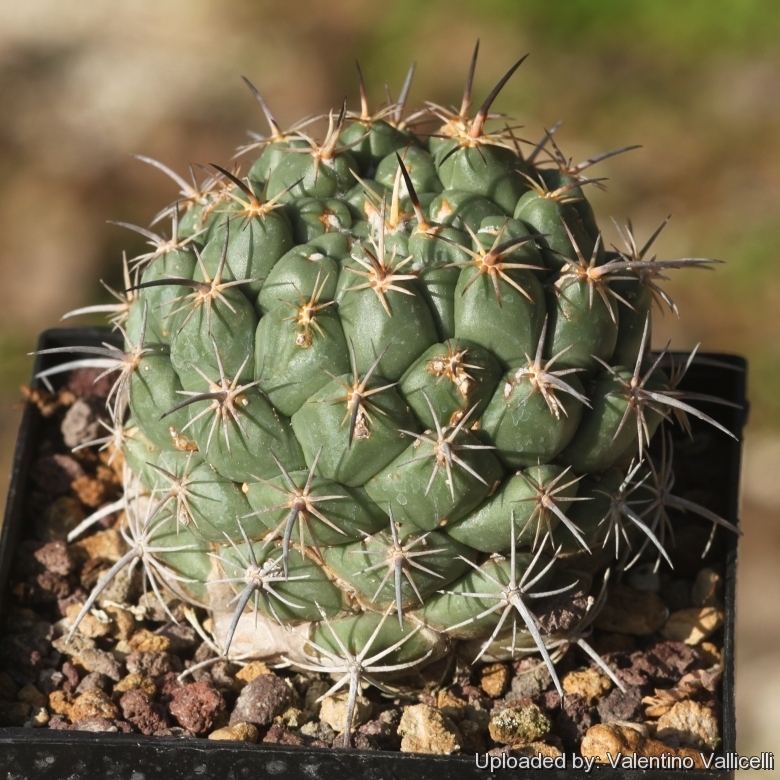
Coryphantha longicornis Photo by: Valentino Vallicelli
Origin and Habitat: Durango - Mexico (North America)
Synonyms:
See all synonyms of Coryphantha longicornis
back
Accepted name in llifle Database:Coryphantha longicornis Boed.Monatsschr. Deutsch. Kakteen-Ges. 11: 249, fig. 1931Synonymy: 2
back
Common Names include:
SPANISH (Español): Biznaga de Piña
Description: Coryphantha longicornisSN|10216]]SN|10216]] is a large growing and solitary or group forming cactus with woolly stem tips.
Stem: Fat squat globose to short cylindrical glossy green or dull green, up to more than 9-20(-30) cm high and 10-15 cm broad.
Tubercles: Spirally arranged, conical/ovate, more or less erect, very firm, 14–17 mm wide up to 2 cm long with a narrow, bare groove above; on new growth the groove may show some felt. Axil bare or slightly woolly with one gland.
Areoles: Woolly when young.
Central spines: 3, rigid, stiff, white to brown, often with black tips, about 1.2-2,5 cm long. The lower one is curved and descending, while the upper and lateral ones are shorter.
Radial spines: About 12, translucent whitish, acicular, acicular, equal straight or curved, short, gray at tips , 5-15 mm long.
Roots: Taproot.
Flowers: Diurnal pure yellow, funnel shaped, 3 to 6,5 cm diameter.
Fruits: Yellow green 15-20 mm long, juicy with attached flower remnants.
Subspecies, varieties, forms and cultivars of plants belonging to the Coryphantha longicornis group
 Coryphantha grandis L.Bremer: has shorter central spines and larger stems with more spiral ribs. Distribution: valley of the Rio Nazas stretching east from El Palmito, Durango, Mexico.
Coryphantha grandis L.Bremer: has shorter central spines and larger stems with more spiral ribs. Distribution: valley of the Rio Nazas stretching east from El Palmito, Durango, Mexico. Coryphantha longicornis Boed.: has 1-3 central spines, rigid, stiff, white to brown, often with black tips, about 1.2-2,5 cm long, and about 12 radial spines. Distribution: Durango - Mexico.
Coryphantha longicornis Boed.: has 1-3 central spines, rigid, stiff, white to brown, often with black tips, about 1.2-2,5 cm long, and about 12 radial spines. Distribution: Durango - Mexico.
Notes: This is a variable species especially regarding the length of the lower central spine. The plants with shorter central spines are sometime referred as Coryphantha grandisSN|10216]]SN|10217]], while those with longer centrals are referred as Coryphantha longicornisSN|10217]]SN|10216]]. (But this classification is arbitrary and intermediate form are commonly found either in habitat and in cultivation).
Bibliography: Major references and further lectures
1) Edward Anderson “The Cactus family” Timber Press, Incorporated, 2001
2) Nathaniel Lord Britton, Joseph Nelson Rose “Cactaceae: Descriptions and Illustrations of Plants of the Cactus Family” vol. 4 The Carnegie Institution of Washington, Washington 1923
3) James Cullen, Sabina G. Knees, H. Suzanne Cubey "The European Garden Flora Flowering Plants: A Manual for the Identification of Plants Cultivated in Europe, Both Out-of-Doors and Under Glass" Cambridge University Press, 11/Aug/2011
4) David R Hunt; Nigel P Taylor; Graham Charles; International Cactaceae Systematics Group. "The New Cactus Lexicon" dh books, 2006
Cultivation and Propagation: In culture it is without problems, and regularly shows its large yellow flowers. It does best in slight shade, but does well in full sun too. It is sensitive to overwatering (rot prone), and needs a very porous soil with good drainage. It flowers quite early, but needs about 8-12 years to reach the typical, definite outlook. It tolerates fairly low temperatures as long as it is kept dry (hardy to -5° C or less for short periods of time).
Propagation: Propagation is by seed.











